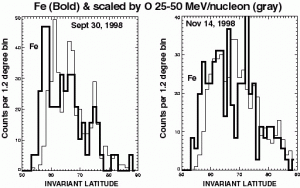SEP events: MAST measurements
The Mass Spectrometer Telescope (MAST) instrument on SAMPEX, which was built by Caltech and GSFC, is designed to measure the elemental and isotopic composition of nuclei from He to Ni (Z = 2 to 28) over the energy range from ~15 to 200 MeV/nuc.
Analysis of MAST data in other Solar Energetic Particle (SEP) events since the previously reported November 1997 event continues apace. With the restoration of the four position sensitive detectors in August of 1998, the full capabilities of MAST for SEP measurements can be applied as solar maximum approaches. We are currently looking at two separate SEP events; one commencing on September 30, 1998, the other on November 14, 1998. Both events appear to have sufficient statistics for studying iron at energies of 25-50 MeV/nucleon. These events also show enrichments in heavy elements and isotopes in measurements from SIS in ACE, which suggest that the ionic charge states may be higher than typical for gradual events.
By taking advantage of the polar orbit of SAMPEX in the magnetic field of Earth, measurements by MAST of mass and energy can be used to determine latitude distributions of the nuclei and thus their geomagnetic cutoff rigidity. With sufficient statistics it is possible to determine the mean particle charge states. The technique is applicable to higher energy nuclei than accessible by electrostatic deflection and is the only way at present to measure charge states at SIS energies.
As the accompanying figure shows (see , the selected events show penetration by iron (thick line in the figure) to 2 or 3 degrees lower invariant latitudes than oxygen (thin line) at the same energy per nucleon; thus, the SEP iron ions are less fully stripped of their orbital electrons than are the oxygen ions. After calibrating the relation between the magnetic latitudes of the cutoff and the particle magnetic rigidities, histograms of the type shown in the figure will allow us to measure the mean charge of the iron and oxygen ions.
As SAMPEX continues observations during the approaching solar maximum we will determine how much the charge states vary from event to event. The overlap with ACE will also allow us to carry out further collaborative studies, and assist in the interpretation of ACE/SIS observations.
Contributed by Doug Larson, Caltech
«Return to the Results page
